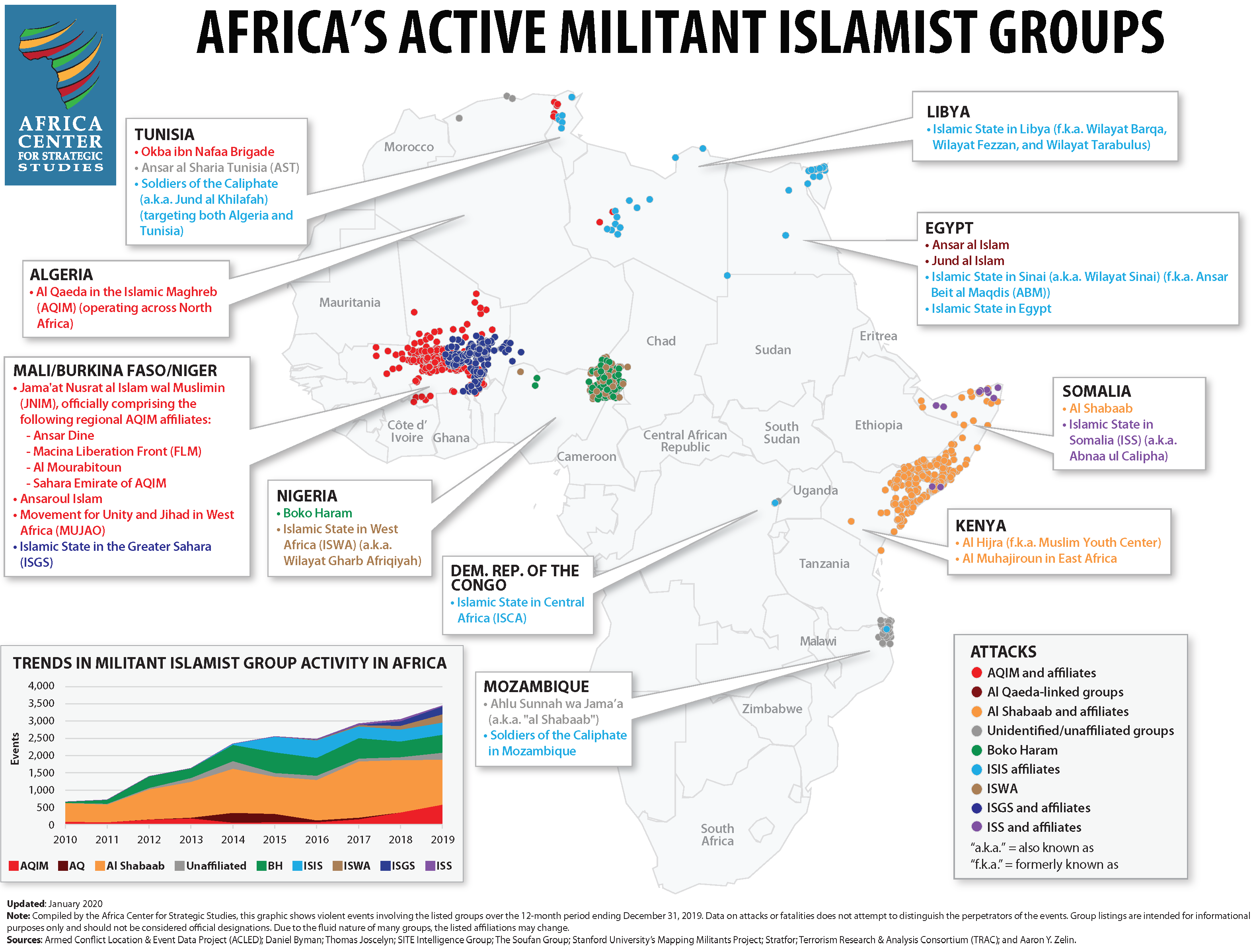- Militant Islamist groups in Africa set a record pace of activity in 2019. There were 3,471 reported violent events linked to these groups in the past year, a 14-percent increase over the previous 12 months. This reflects a doubling of militant Islamist group activity in Africa from 2013.
- Reported fatalities linked to African militant Islamist group activity also rose, by 7 percent over the previous year, to an estimated 10,460 deaths. This reverses a downward trend in fatalities seen since 2015.
- The threat from militant Islamist groups in Africa is not monolithic but comprises activity from a constantly shifting mix of roughly two dozen groups actively operating in 14 countries.
- While still largely concentrated in five main theaters, the distribution of militant Islamist group activity across the continent has grown more dispersed. Previously, Somalia accounted for roughly half of all such events in Africa. This picture has shifted to one that is more evenly dispersed across Somalia, the Lake Chad Basin, and the Sahel—with lesser but persistent threats in North Africa and Mozambique. Each theater faces unique dynamics.
Somalia Theater
- There has been a significant decline in al Shabaab activity (almost 14 percent) and even more so with regard to reported fatalities linked to al Shabaab (a 29-percent decline since 2018 and 40-percent since 2017).
- Violent activity linked to al Shabaab now represents roughly 38 percent of all militant Islamist group events in Africa (compared to 50 percent for much of the past decade) and almost 27 percent of reported fatalities linked to such events—a significant decline from the overall pattern of the past few years.
- While the decline in violent activity in Somalia represents improvements in security in Mogadishu, al Shabaab continues to exert widespread influence in outlying areas.
- The decline in activity by al Shabaab has been offset by increases in three of the other four theaters on the continent.
Sahel Theater
- The Sahel (specifically the countries of Burkina Faso, Mali, and Niger) has seen the most rapid increase in violent extremist activity of any region in 2019. The 800 events observed represent the continuation of a near doubling of events involving militant Islamist groups in the Sahel every year since 2015.
- 2019 also saw the locus of these violent attacks shift from Mali to Burkina Faso.
- Fatalities from events in the Sahel are estimated to be around 2,600 (also a doubling from the previous year).
- Three groups, the Macina Liberation Front, the Islamic State of the Greater Sahara, and Ansaroul Islam account for the vast majority of these attacks. All are formally or informally associated with a consortium of groups linked to al Qaeda in the Islamic Maghreb known as Jama’at Nusrat al Islam wal Muslimin (JNIM).
Lake Chad Theater
- Two groups, Boko Haram and its off-shoot, the Islamic State in West Africa (ISWA), are largely responsible for the militant Islamist group activity in the Lake Chad Basin (straddling four countries—Nigeria, Niger, Cameroon, and Chad). In this theater, 765 violent events were reported in 2019—a 35-percent increase from the previous year. While Boko Haram is responsible for the majority of reported violent events in the region, and for the most attacks on civilians, ISWA experienced the largest growth of reported violent activity in the region over the past year.
- Combined reported fatalities from activity linked to Boko Haram and ISWA (about 3,225) represent a 4-percent increase from 2018. For perspective, this figure exceeds those fatalities linked to al Shabaab (roughly 2,790) or the Sahel (2,600) in 2019.
- Within the Lake Chad Basin, Cameroon, Niger, and Chad all saw significant increases in violent activity linked to militant Islamist groups in 2019, while the pattern in Nigeria was relatively unchanged.
North Africa Theater
- Violent events involving the Islamic State (ISIS) in North Africa (primarily Egypt, Libya, and Tunisia) have remained flat in 2019 with 347 reported episodes compared to the 345 observed in 2018. The roughly 1,060 fatalities linked to these events, however, represent a 9-percent drop from 2018. The plateauing of ISIS activity in North Africa could reflect the outcome of heightened countermeasures in Egypt and Tunisia. However, the ongoing instability in Libya masks militant Islamist group activity there, which may provide a refuge for resurgent extremist violence in this region.
Northern Mozambique Theater
- There was a tripling of violent episodes linked to militant Islamist groups in northern Mozambique reported in 2019—to 200 and some 710 associated fatalities. By contrast, there was no militant Islamist activity in Mozambique in 2016. The group(s) active in this region, which go by the names Ahlu Sunnah wa Jama’a (ASWJ) or “al Shabaab” (though no relation to the group in Somalia), have murky origins, have exploited a deep-seated sense of marginalization, and have grown with an indiscriminate government response to the violence. Actors claiming links to ISIS have taken responsibility for some six attacks in Mozambique this year. Given these factors, the prospects for a continued escalation in this theater appear likely.
More on: Countering Violent Extremism Al Shabaab AQIM Burkina Faso Extremism Mali Somalia


